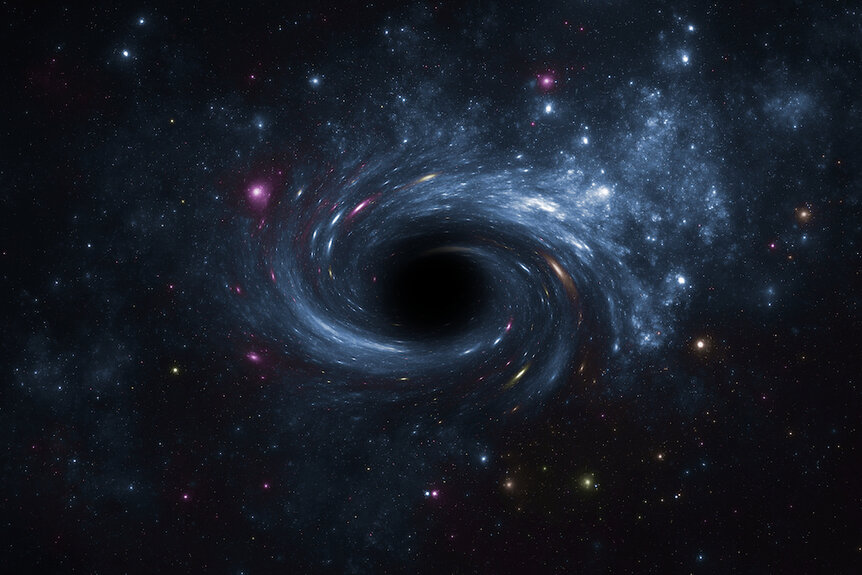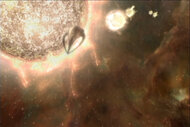Create a free profile to get unlimited access to exclusive videos, sweepstakes, and more!
JWST Spies Oldest Black Hole Ever Found at the Fringes of the Known Universe
We're not quite sure how it got there.

When Marty McFly (Michael J. Fox) went back in time in Back to the Future (streaming now on Peacock) he saw some stuff and did some stuff he probably shouldn’t have. Then again, he was a teenager with the fate of the time continuum in his hands. That’s heavy stuff, we’ll cut him some slack.
Our real-world telescopes can’t travel through time – except in the ordinary, getting older every day kind of way – but they can see through time. Humanity’s space-based observatories peer into the far distance, glimpsing stars, planets and galaxies millions or billions of light-years away. Because light travels at a fixed velocity, the farther away you look, the farther back in time you’re seeing. Recently, the James Webb Space Telescope (JWST) spotted the oldest and most distant black hole we’ve ever seen. How’s that for horrors from the past?
Astronomers Spot Oldest Observed Black Hole at the Edge of the Universe
Scientists used the telescope’s Mid-Infrared Instrument (MIRI) and the Near Infrared Camera (NIRCam) to squint into the cosmic backdrop and pick out a black hole. They found one and it’s a doozy. Roughly 13 billion light-years away, astronomers caught sight of a black hole 1.6 million times the mass of the Sun. The results of their findings have been posted to the pre-print server arXiv and have not yet been peer reviewed.
RELATED: "Scary Barbie" Black Hole Slurps Up a Star Like Spaghetti
The more astronomers look, the more they find these monster black holes happily chowing down in the first few hundred million years after the Big Bang. That there are black holes in the early universe isn’t all that surprising, but that they’re that massive is a little unexpected. These days, we have way more glutinous black holes; the supermassive black hole at the center of our own galaxy has an estimated mass of 4.3 million Suns. But it has had more than 13 billion years to fill its singular larders. How exactly these early black holes got so big, so fast, isn’t known.
Astronomers targeted a distant but highly luminous galaxy known as GN-z11. It was originally detected by Hubble but JWST’s cutting edge instruments upped the resolution and detail. Scientists suspected there might have been something going on in or near GN-z11 because it’s so bright (relatively speaking, it’s super far away). It seemed unlikely that it could pump out that much light through star formation alone. When researchers peeped the galaxy through JWST they found evidence of an accreting black hole (one in the process of gobbling up material). It’s likely that the black hole in question is an active galactic nucleus (AGN) not unlike the black hole at the center of the Milky Way.
RELATED: There Might Be Stealth Black Holes Hiding in Our Cosmic Backyard
Black holes famously don’t emit light, which makes them difficult (impossible) to see, but active black holes light up the material around them, giving away their position. If a star, planet, or any other matter gets too near a black hole, it will start spiraling in toward the singularity like a dead goldfish circling the drain. Only, it isn’t just a goldfish. It’s stars and planets all spinning around and breaking up, smashing into one another and heating up in the friction of freefall. The black hole doesn’t emit light, but all of that heat does, and we can see it like a sweltering boundary around the event horizon.
That distant, supermassive black hole might have formed when immense primordial clouds collapsed directly into a black hole. They might also have been born through the rapid merging of several stars or smaller black holes into dense collapsing clusters. We now know there are monster black holes at the edges of the known universe, and maybe one day we’ll know how they got there.
We’re going to need a lot more than 1.21 gigawatts to travel back that far. Catch the entire Back to the Future trilogy streaming now on Peacock.














